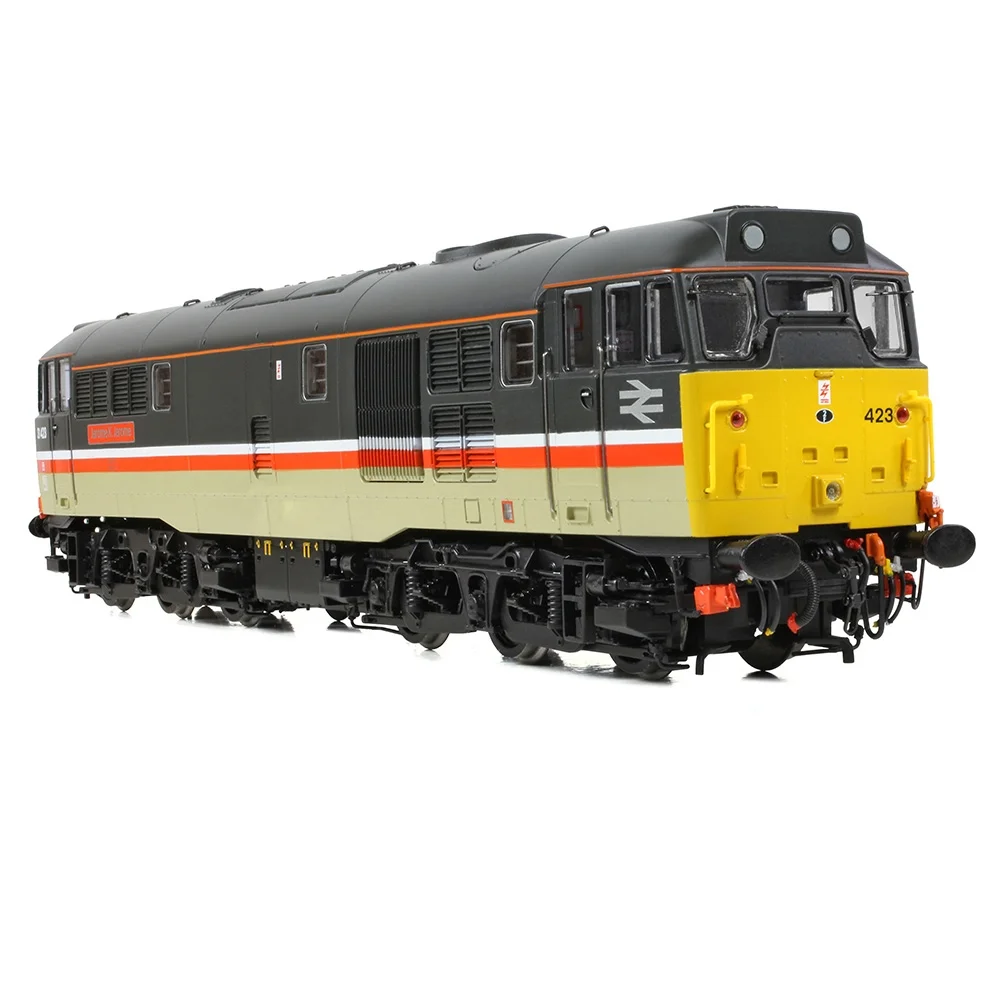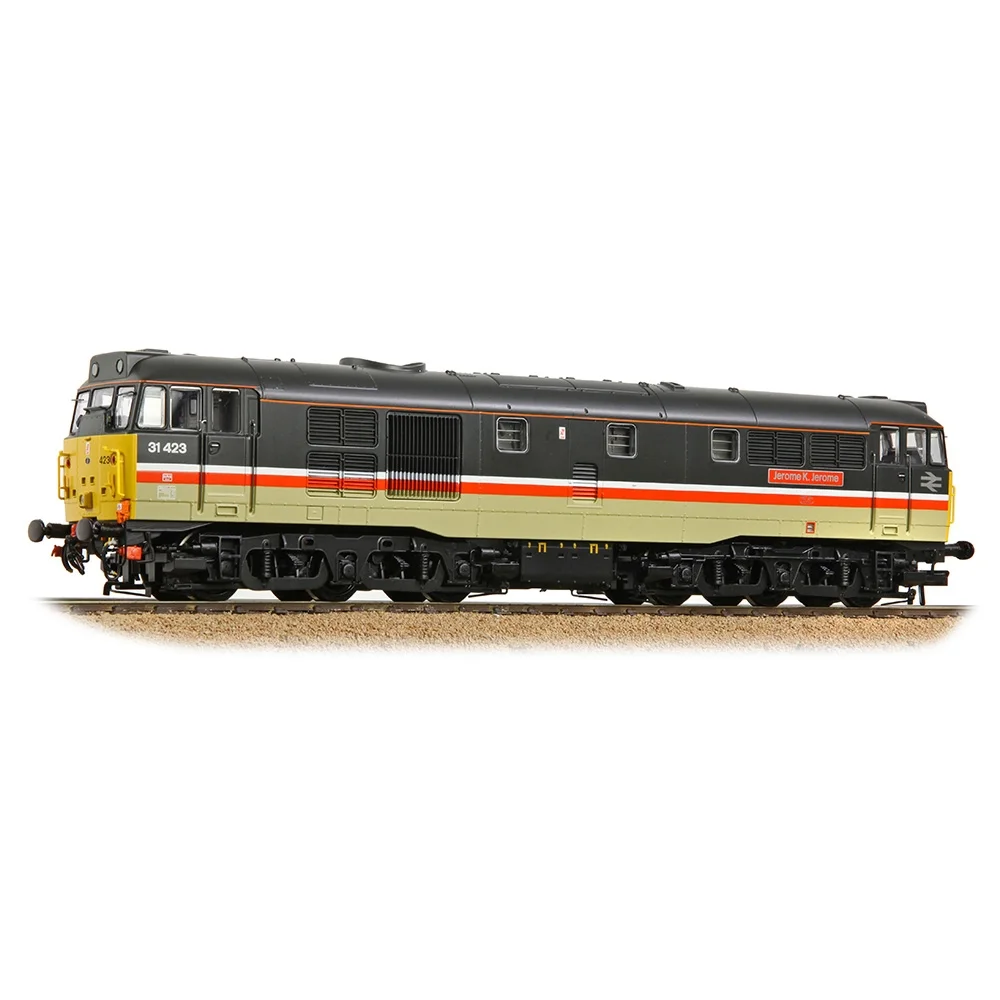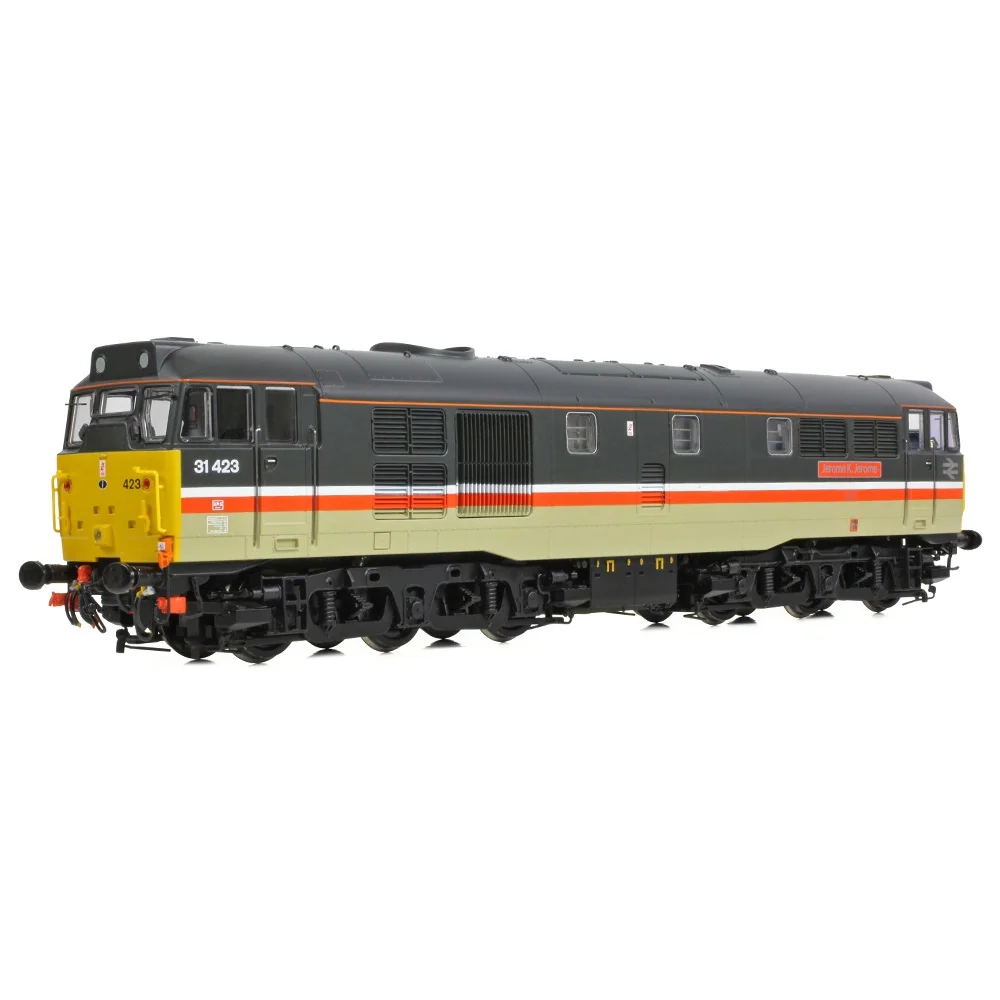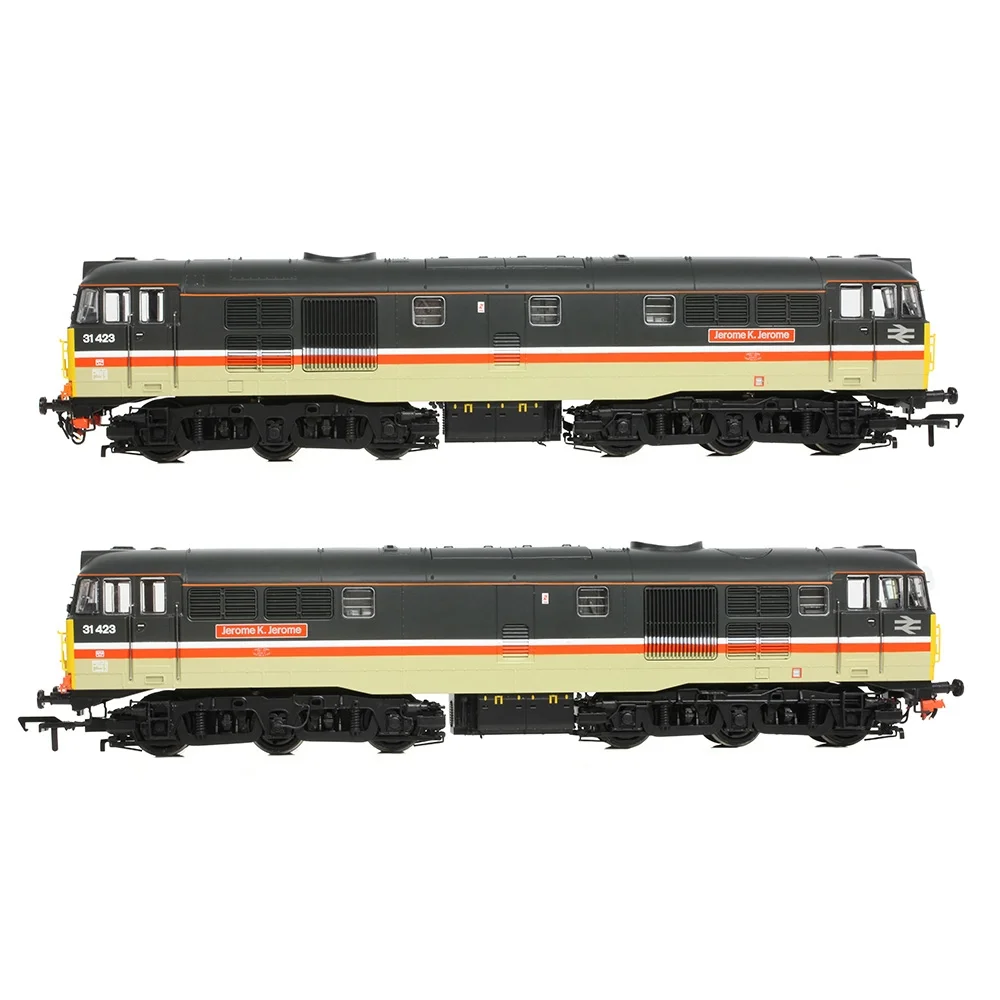Bachmann 35-827SF
British Rail Class 31/4 31423 Jerome K. Jerome British Rail InterCity Mainline
Bachmann's Description & Specifications
The Brush Type Twos – Class 30s and Class 31s – by Bachmann Branchline are back and better than ever, now featuring a Bach-Up Stay Alive System fitted as standard and all-wheel electrical pickup assuring the smooth and powerful performance you’ve come to expect from Bachmann Branchline models.
With high fidelity mouldings, numerous separately fitted parts and countless tooling variations to capture the minutiae of the real locomotives throughout their lives, our new Class 30 is brought to life with an exquisite livery application using true-to-prototype colours, fonts and logos. Along with an unprecedented array of lighting features, our Dual Fitted speaker system is fitted to all models – bringing to life our SOUND FITTED models. For the ultimate experience, choose one of our SOUND FITTED DELUXE models with their motorised radiator fan, authentic tinted windscreen glazing and hands-free DCC-uncoupling thanks to Bachmann’s revolutionary Auto-Release Coupling System!
Depicting a Refurbished Class 31/4 with ETH, this locomotive has had its Mirrlees engine replaced with an English Electric 12SVT and the Branchline model faithfully recreates this, with the correct roof exhaust ports and 12SVT engine block detail visible through the bodyside windows.
- Bachmann Branchline OO Scale
- Era 8
- Pristine BR InterCity (Mainline) livery
- Running No. 31423
- Named ‘Jerome K. Jerome’
- Etched Nameplates Included
- SOUND FITTED - Fitted with a Zimo MS450P22 DCC Sound Decoder
- Length 228mm
DETAIL VARIATIONS SPECIFIC TO THIS MODEL
- Refurbished Body
- Gangway Doors Plated
- Plated Headcode Panels fitted with Marker Lights
- Windscreen Washer Jets with Covers
- Bufferbeam Cowling Removed
- Original Windscreen
- Modified Main Fan Grilles with Vertical Fins
- English Electric Engine Exhaust Ports
- English Electric Engine Block Detail
- Plated Boiler Port
- Plated Water Filler Hatch
- Plated Bodyside Steps
- Battery Boxes with Additional Safety Clips
- NRN Radio Pods
- Roof Fan Grille with ‘Top Hat’
- Electric Train Heating (ETH) Fitted
- High Intensity Headlights
BACHMANN BRANCHLINE CLASS 30/31 SPECIFICATION
MECHANISM:
- Five pole, twin shaft motor with two flywheels providing drive to both bogies
- All axle drive
- Electrical pickup from all wheels on each bogie
- Separate metal bearings fitted to each axle
- Diecast metal chassis block and bogie towers
- Diecast metal gearboxes, with gearing arranged for prototypical running speeds and haulage capabilities
- 16.5mm (OO gauge) wheels to NEM310 & NEM311 standards with authentic profile and detailing
- Detachable coupling pockets to NEM362 standards fitted to each bogie
- Auto-Release Couplings fitted at both ends – DCC operated, hands-free uncoupling with the press of a function button (SOUND FITTED DELUXE models only)
- Designed to operate on curves of second radius (438mm) or greater
DETAILING:
- Bogies constructed from multiple components featuring full relief detail
- Rotating radiator fan, driven by an independent motor and gearbox, operated as part of the sound project on DCC and Analogue control (SOUND FITTED DELUXE models only)
- Tinted windscreen glazing (Driver and Second Man windscreens only as per the prototype, SOUND FITTED DELUXE models only)
- Separately applied metal detail parts, including grab handles, windscreen wipers and etched fan grilles
- Sprung metal buffers
- Each model supplied with a full set of decorated, model-specific bufferbeam pipework and accessory parts including three-piece, body-mounted snow ploughs
LIGHTING:
- Directional lighting, including illuminated headcode panels and high intensity headlights where applicable, switchable on/off at either end on DCC or Analogue control
- Cab lighting*, assigned to two DCC functions for separate switching of each
- Separately switched Engine Room lighting*
- Single or twin red tail lights* (*when used on DCC)
- Authentic light colours and temperatures selected for each model based on era and application
DCC:
- Plux22 DCC decoder interface
- Bach-Up Stay Alive Systemproviding uninterrupted power to prevent stalling, light flicker and sound cut-outs (operates on DCC only)
SOUND:
- Two quality speakers employed for optimum sound reproduction, fitted to every model as standard
- Zimo MS450P22 DCC Sound Decoder fitted to SOUND FITTED and SOUND FITTED DELUXE versions
- Two sound projects to accurately capture the sounds of Class 30 (Mirrlees Engine) and Class 31 (English Electric Engine)
- Sound files for each project produced specifically for the Bachmann Branchline Class 30/31 using recordings from real locomotives and archive audio
- SOUND FITTED and SOUND FITTED DELUXE models operate on DCC and Analogue control as supplied. On Analogue, an authentic engine start up sequence and running sounds are produced when power is applied
LIVERY APPLICATION:
- Authentic liveries applied to all models
- Multiple paint applications employed on each model using BR and corporate specification colours
- Logos, numerals and text added as appropriate using multi-stage tampo printing using authentic typefaces, logos and colours
- In addition, where applicable Etched Nameplates and Plaques are also provided
Class & Prototype
- Class: British Rail Class 31/4
- Traction: Diesel
- Transmission: Electric
- Built: 1957-1962
- Total Built: 263
- Running Number: 31423
- Name: Jerome K. Jerome
- Ordered By: British Railways
- Built By: Brush Traction
- Built At: Brush Traction
- Built: 06/1960
- Withdrawn: 09/1996
- Length of Service: 36.3 years
- Running Numbers: BR D5621, BR 31197, BR 31423
- Names: Jerome K. Jerome
The Brush Type 2 represents one of British Railways' most remarkable transformation stories. Built by Brush Traction between 1957-1962, these 263 A1A-A1A diesel-electric locomotives initially struggled with unreliable Mirrlees engines, earning TOPS classification as Class 30. The comprehensive re-engining programme of 1964-1969 replaced the problematic powerplants with proven English Electric 12SVT engines, transforming them into dependable Class 31 locomotives that served for over 50 years. Originally nicknamed "Toffee Apples" (pilot batch) and "Skinheads" (early production), they evolved from operational liability to versatile workhorse, handling everything from branch line passenger services to main line freight duties. The class demonstrates how systematic engineering solutions can rescue unsuccessful designs, with the final locomotive withdrawn in 2017 after six decades of service. Today, 36 examples survive in preservation, whilst excellent ready-to-run models from Accurascale, Hornby, and Bachmann enable authentic recreation of both Class 30 and Class 31 configurations across multiple scales and eras.
D5621 was built by Brush Traction in June 1960 for the Eastern Region, entering service in BR green with small yellow warning panels. Like its classmates, it began life as a Class 30 with a Mirrlees JVS12T engine, but was re-engined with the English Electric 12SVT in the late 1960s, becoming a Class 31/1.
By the end of the 1960s, the "D" prefix was dropped, and it ran as 5621 in BR blue during the short pre-TOPS period. Under the TOPS scheme, it became 31197 in March 1974. In January 1975, it was fitted with Electric Train Heating (ETH) equipment, which reclassified it as a Class 31/4 and saw it renumbered 31423.
A highlight of its career came in May 1990, when it was named "Jerome K. Jerome" after the famous author of Three Men in a Boat. It retained the name until February 1997. During its later years, 31423 was a regular on passenger services in the North West and Midlands, including cross-regional duties.
After 36 years in service, it was withdrawn in September 1996. For modellers, 31423 offers a wealth of era-specific options—from green with a "D" prefix, through plain-number BR blue, to TOPS-era blue with ETH fittings, and finally a named Class 31/4 in the 1990s.
Operator & Livery
- Operator: British Rail InterCity
- Livery: Mainline
- Era: 8 - British Rail Sectorisation
British Rail InterCity was the premium express passenger brand that operated from 1966 to 1997, transforming long-distance rail travel across Britain. Initially launched as a marketing brand for high-speed services, InterCity became an autonomous business sector in 1982 under the sectorisation programme, operating profitable express services from London to Scotland, Wales, the West Country, and extensive cross-country routes.
The brand pioneered revolutionary rolling stock including the iconic InterCity 125 HST (High Speed Train) from 1976, which achieved 125mph operations on existing infrastructure, and the electric InterCity 225 sets from 1989, capable of 140mph but limited to 125mph in service. InterCity also developed the ground-breaking Advanced Passenger Train (APT) with tilting technology that influenced modern high-speed trains worldwide.
Distinguished by its evolving livery schemes - from Rail Blue and Grey through the sophisticated Executive livery with dark grey upper bodies and red stripes - InterCity became synonymous with quality, speed, and reliability. All day services featured buffet cars and the majority operated at 100mph or above, making British Rail one of the world's most intensive high-speed operators.
The brand was divided among multiple operators during railway privatisation in the 1990s, but its technical innovations, operational excellence, and commercial principles continue influencing modern rail services. InterCity remains hugely popular with railway modellers, with extensive ranges of locomotives and coaching stock available in all major scales from manufacturers like Hornby, Bachmann, and Heljan.
BR Mainline livery was introduced in 1989 as part of a comprehensive rebranding programme that modified the InterCity image whilst creating a neutral livery for locomotives working across multiple sectors. This livery was applied to locomotives that might operate for both InterCity and freight sectors, deliberately avoiding the InterCity brand being associated with freight operations.
The Mainline livery scheme consisted of dark grey upper body panels with beige (sometimes described as fawn or biscuit) lower sections, separated by the distinctive red and white horizontal stripe below the windows that had characterised InterCity Executive livery. Crucially, Mainline livery featured the traditional BR double arrow logos rather than InterCity branding, making it suitable for locomotives that might work freight or parcels traffic.
On locomotives, the scheme typically included a white lower body section rather than the beige used on coaching stock. Power cars and locomotives featured half-yellow front ends with black-outlined cab windows, maintaining safety visibility standards whilst providing a smart, professional appearance.
The livery was applied extensively to Class 86, 87, and 90 electric locomotives, numerous Class 47 diesels, some Class 37s, and other traction types that operated across sector boundaries. Many locomotives carried this livery only briefly before receiving full InterCity Swallow branding or being transferred to freight sectors with appropriate liveries.
For modellers, Mainline livery offers an authentic intermediate stage between InterCity Executive and Swallow schemes, representing the late 1980s transition period when British Rail was refining its sectoral branding. The livery's neutral character makes it suitable for mixed traffic operations on model railways, whilst its smart appearance maintains the quality associated with InterCity operations.



